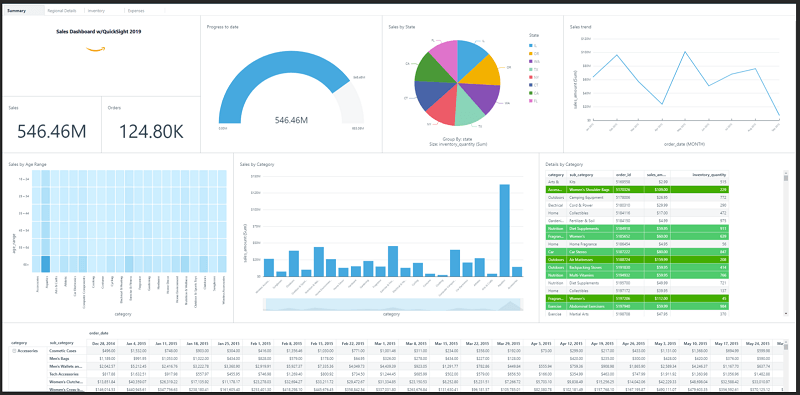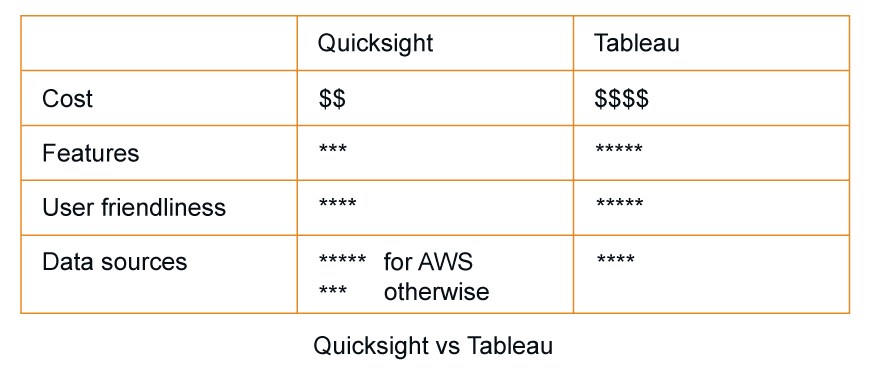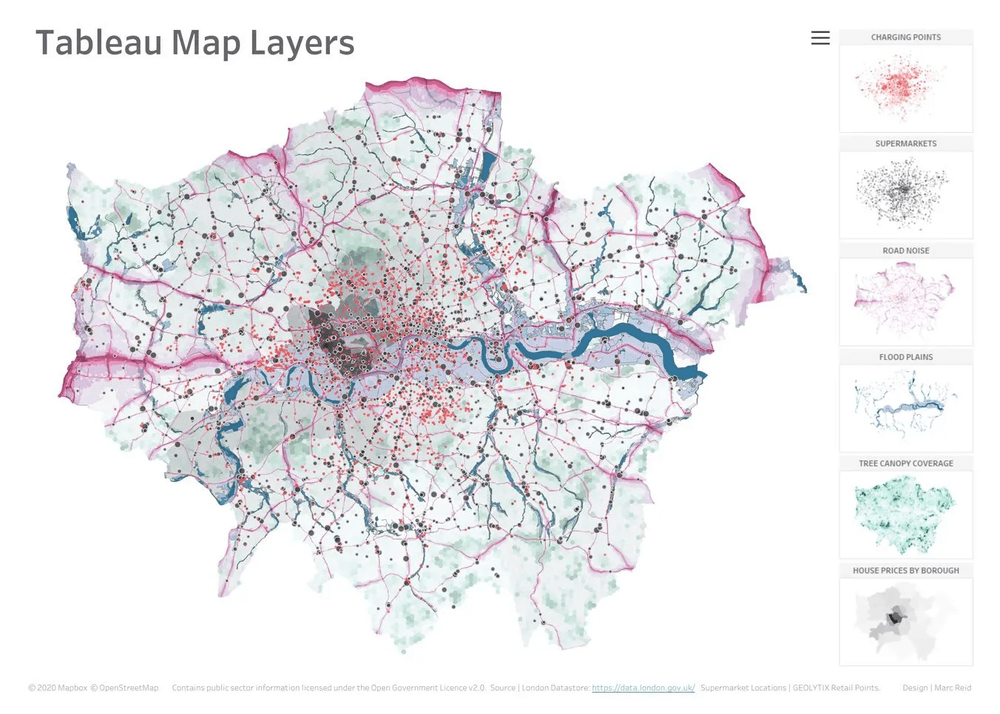Quicksight and Tableau are 2 popular BI solutions. Which one to choose?
Simply put, Quicksight is the simple and cheap option, while tableau makes more advanced analytics for higher costs
Here are some questions we’ll answer in this article:
- What are Quicksight and Tableau?
- Can I use Quicksight with Azure or Google Cloud. Can I use Tableau for that?
- What does Tableau have that Quicksight doesn’t? Should I pay more for it?
Let’s get started.
What Are Quicksight vs Tableau
Quicksight and Tableau are two business intelligence (BI) solutions. They help you turn complex datasets into easy-to-understand visualizations like charts and graphs. With these visuals, you can analyze and interpret data. With a BI tool you’ll make data-backed business decisions.
Now let’s compare two popular solutions: Quicksight and Tableau.


Data sources
Quicksight is great if you use AWS, and Tableau has more data sources overall.
Quicksight is seamless for AWS data sources S3 or AWS IoT. If you use another cloud, it’s best to go for Tableau.
But it also supports the main databases like MySQL, PostgreSQL, and Oracle. There’s also support for JSON, Excel, CSV, XLSX, and ELF files.
Tableau has a much larger list of source connections. Quicksight wins in AWS support, but in everything else Tableau beats Quicksight.
It also supports AWS services like Athena, Aurora, EMR Hadoop Hive, Redshift, and even Amazon S3 (though in beta).
Tableau supports many services that Quicksight doesn’t: Azure, Google Cloud, Mongo. It supports PDF, text, and other files.
Features
Visualization. Both are great for basic data analysis with tons of visualization options, but Tableau is more advanced in some ways, like maps. Just look at how advanced the maps are.

User friendliness. Both tools are well-made and with beautiful dashboards. But Tableau takes a slight edge, because of the small things. For example, there’s still no drag and drop option in Quicksight – but there is in Tableau.
Hosting. Tableau offers both on premise and cloud options, but the cloud is very limited. Quicksight is always cloud based.
OS support. Both tools are multiplatform. You can create data analytics on Windows, Mac, Linux, and mobile.
Development environment. Tableau development is desktop based, and AWS is cloud based. It’s much easier to develop instances in the cloud, because you won’t have to pass around files, and it’s just easier to start.
Mobile app. Both Tableau and Quicksight have mobile applications allowing you to get data insights from anywhere.
AI copilots. Both Tableau and Quicksight support NLP analytics, so you can generate reports with plain English language.
Machine learning development. Tableau supports custom ML models built with Python and R. Quicksight makes you use prebuilt AWS machine learning models.
Row-level security. You can manage access to individual rows in both Tableau and Quicksight.
Embed Analytics. Both tools allow embedding your data into 3rd party apps, but Quicksight will make you pay for it.
Pricing: Quicksight vs Tableau
Tableau is expensive, but straightforward. You pay for each user’s license.
Here’s how much the licenses cost:
- 72$ for creator. These are admin licenses that help you manage your Tableau instances, create new data sources, and export reports. You’ll need at least 1 creator license to start.
- 42$ for explorer. With explorer rights you’ll use existing data sources to create new workbooks.
- 15$ for viewing. As the name goes, this license allows you to view created reports.
The cheapest possible option is $900 annually. The cheapest license is $72 a month, because every deployment requires at least one creator license. There are no monthly payment options, so you’ll have to pay yearly for each license.
Some of the secondary tools are sold separately. If you need data modeling or data preparation tools, you need to budget for them.
There is a free trial option, and a free year of Tableau for students and teachers.
Quicksight is cheaper, but harder to calculate the exact price.
You can start with just a $24 admin license monthly, though annual license is cheaper long-term. Much more affordable start compared to $900 with Tableau.
For reading permissions, there are 2 pricing models: per user or per session. You can pay either $0.3 per user session, or buy sessions in bulk. Note, that you’ll pay extra for paginated reports or embedding Quicksight into other applications. For more details head to the Quicksight pricing page.
There is a free monthly trial for 4 author licenses.
Do I need Tableau or Quicksight?
That depends on your case. Both are great, but one may be better. Need on-premise hosting? Go for Tableau. Or choose Quicksight for cloud development. If you’re looking for a cheaper solution, and don’t need much customization – choose Quicksight. Pick Tableau if you need a more customized BI tool.
Both handle enterprise projects well. Quicksight is great if you host on AWS. It’s much cheaper than Tableau, and the AWS integrations make it worthwhile.
For example, we used Quicksight on our elearning platform with 10+ million users. It’s tough handling a 20GB database with 50 million entries. But AWS services let us automate a lot. No need to manually manage databases, we can treat infrastructure as code. We code the templates, and the rest is automated. With AWS CloudFormation, we automatically deploy Quicksight resources
If you need more help choosing or setting up Tableau or Quicksight, reach out for a free consultation. Let cloud development experts handle the tech and optimize your BI. Make informed decisions whether you are in EdTech, logistics or other industries.




